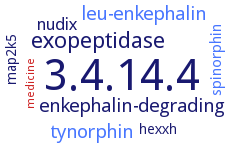3.4.14.4: dipeptidyl-peptidase III
This is an abbreviated version!
For detailed information about dipeptidyl-peptidase III, go to the full flat file.

Word Map on EC 3.4.14.4 
-
3.4.14.4
-
exopeptidase
-
tynorphin
-
enkephalin-degrading
-
leu-enkephalin
-
nudix
-
spinorphin
-
hexxh
-
map2k5
-
medicine
- 3.4.14.4
-
exopeptidase
- tynorphin
-
enkephalin-degrading
- leu-enkephalin
-
nudix
- spinorphin
-
hexxh
-
map2k5
- medicine
Reaction
release of an N-terminal dipeptide from a peptide comprising four or additional information residues, with broad specificity. Also acts on dipeptidyl 2-naphthylamides. =
Synonyms
BT_1846, Cabys_2252, dipeptdiyl peptidase III, dipeptidyl aminopeptidase III, dipeptidyl arylamidase III, dipeptidyl peptidase III, dipeptidyl-peptidase III, dipeptidyl-peptide hydrolase, dipeptidylpeptidase III, DPP III, DPP-3, DPP-III, DPP3, DPPIII, enkephalinase B, NUDT3, peptidase, dipeptidyl, III, PG_0317, PHYPA_007037, red cell angiotensinase
ECTree
Advanced search results
Crystallization
Crystallization on EC 3.4.14.4 - dipeptidyl-peptidase III
Please wait a moment until all data is loaded. This message will disappear when all data is loaded.
molecular modelling study of wild-type and its C450S mutant, as well as their complexes with substrates Arg-Arg-2-naphthylamide and Lys-Ala-2-naphtylamide
-
the ligand-free structure (refined to 2.4 A) is in the open conformation, while in the presence of the inhibitor Tyr-Phe-NHOH, the closed form (refined to 3.3 A) is observed. Compared to the closed form, the two domains of the open form are rotated away from each other by about 28 degrees
molecular dynamics simulations of the complex with luteolin. The 3' and 4' hydroxyl group on B-ring as well as 5 and 7 hydroxyl group on A-ring helps luteolin to interact with the Asn391, Asn406, Tyr417, His450, Glu451, Val447, Glu512, Asn545, Gln566, and Arg572 residues
molecular modeling of docking. Aprotinin interacts by its canonical binding epitope with the substrate binding cleft of DPP III. Thereby, free N-terminus of aprotinin is distant from the active-site zinc. The enzyme-inhibitor complex is stabilized by intermolecular hydrogen bonding network, electrostatic and hydrophobic interactions which mostly involve constituent amino acid residues of the DPP III substrate binding subsites S1, S1', S2, S2' and S3'
QSAR and molecular dynamics simulation of inhibitor binding. Compounds that contain two imidazolinyl groups, with only one sp3-hybridized nitrogen atom each, are potent inhibitors. Most of the interactions of imidazolinyl groups are achieved by electrostatic forces with the residuals Ser108, Gly110, Tyr318, and Ala416 of the lower domain, and with the residuals Tyr417, Asn545, and Glu667 of the upper domain. The phenyl groups of compound 6-(4,5-dihydro-1H-imidazol-2-yl)-2-[(E)-2-phenylethenyl]-1H-benzimidazole interact mainly by means of van der Waals and electrostatic forces with the residuals Ile386, Pro387, Ala388, Phe556, Gln566, and Met569, as well as the cyclobutane ring with His568
structures of human DPP III and its complex with the opioid peptide tynorphin, to 1.8 A and 2.4 and.0 A resolution, respectively. Structures rationalize the enzymes substrate specificity and reveal an exceptionally large domain motion upon ligand binding. Microcalorimetric analyses point at an entropy-dominated process, with the release of water molecules from the binding cleft as the major thermodynamic driving force
the C130S mutant is crystallized by sitting drop vapour diffusion method, in 20% (w/v) polyethylene glycol 3350 and 900 mM MgCl2 in 100 mM Tris-HCl (pH 7.0)
-


 results (
results ( results (
results ( top
top





